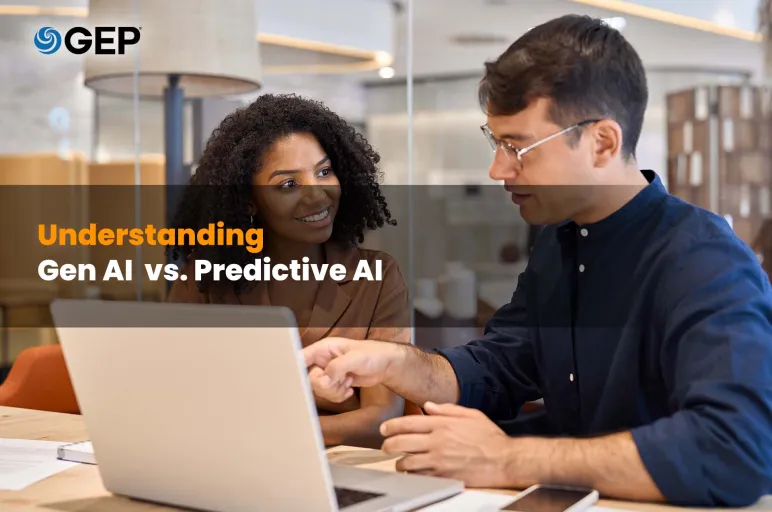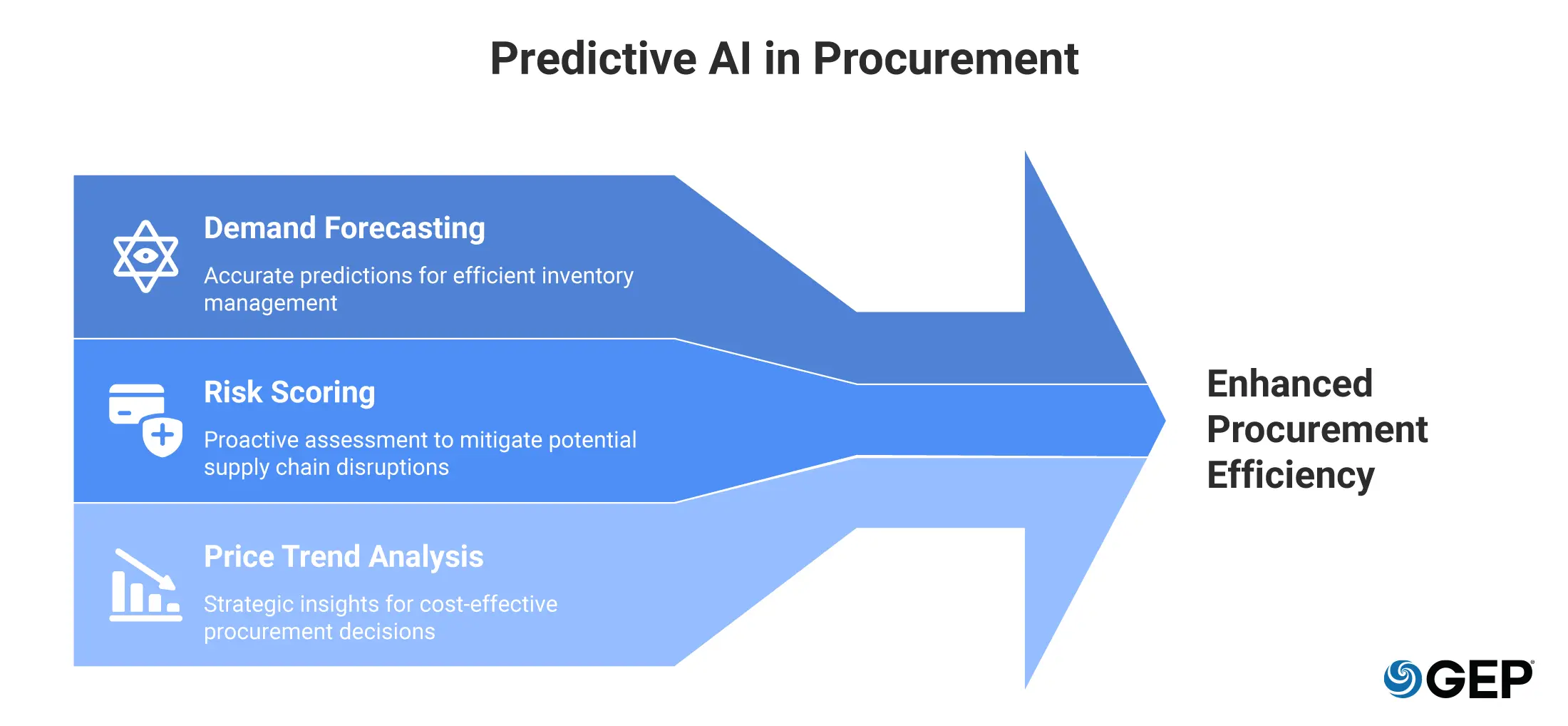
Gen AI or Predictive AI: Why Procurement Needs Both
- Predictive AI looks at historical data to forecast what might be coming next, whether it's demand spikes, price changes or supply risks.
- Generative AI can write things for you, like contracts, negotiation strategies or risk reports.
- Together, they can help procurement teams work smarter, stay compliant, and make better decisions.
November 12, 2025 | Procurement Software 5 minutes read
Since its launch, Generative AI (or Gen AI) has become a buzzword in the industry. Like many other functions, it has got procurement and supply chain professionals interested. But to keep up with this recent explosion of Gen AI applications, procurement leaders need to understand the fundamental difference between this new technology and the Predictive AI models they are already using.
Predictive AI tells you what’s likely to happen, while generative AI helps you decide what to do next by creating the content required for action. Understanding this distinction is key to unlocking the next wave of efficiency and strategic value in your organization.
Understanding Predictive AI in Procurement
Procurement teams use predictive AI to see what's coming before it hits. Predictive AI can analyze transaction logs, inventory levels and pricing history to forecast demand, identify risks and spot price trends. Think of it as turning your historical data into actionable predictions. Here's what procurement teams use it for:
Demand Forecasting:
Figuring out how much material you'll need based on past consumption and seasonal patterns
Risk Scoring:
Gauging whether a supplier might default or if a shipping route is headed for trouble
Price Trend Analysis:
Predicting where commodity prices are going so you can hedge accordingly
What you get back is usually a score, a trend line or a probability: something that helps you make a call. It's great for optimization, but it won't write your contracts or build your strategy.
What Can Generative AI Do in Procurement?
Generative AI uses deep learning on massive datasets (including unstructured data like emails and contracts) to create new content. It's about creation, not just calculation. Gen AI becomes your co-pilot:
- Drafting Documents: Writing first drafts of RFPs, contract clauses, or supplier risk reports
- Summarization and Synthesis: Condensing hundreds of pages into concise, actionable summaries
- Simulation: Creating negotiation scripts or modeling sourcing scenarios
Gen AI takes analytical insights and translates them into tangible outputs, making processes faster and more intuitive.
A Comparison of Generative AI and Predictive AI Across Industries
Both Predictive and Generative AI have a transformative impact on business operations, but their applications vary by industry.
Predictive AI Applications in Automotive Manufacturing
Predictive AI is crucial for supply chain continuity. It monitors production schedules to predict when components will run out and calculates optimal buffer stock for just-in-time processes, minimizing costly shutdowns.
Generative AI Applications in Automotive Manufacturing
Gen AI is better suited to handling design and sourcing, analyzing component specifications and drafting Statements of Work based on historical documents. It simulates material substitutions to model TCO impact and generates compliance reports instantly.
Predictive AI in Higher Education
Universities face major capital expenses, and getting forecasts wrong is costly. Predictive AI digs into utility bills, enrollment patterns, and maintenance logs to predict when that aging HVAC system will fail or how much concrete you'll need for the new science building. This gives procurement teams time to budget and tender properly instead of scrambling when something breaks.
Generative AI in Higher Education
University purchasing policies can run hundreds of pages, and nobody reads them all. Gen AI takes those rulebooks and creates a clear, step-by-step guide for users who just need to know how to buy that one piece of lab equipment. Compliance happens without anyone wading through a policy manual.
Predictive AI in the Public Sector
Public sector procurement lives or dies by risk management. Predictive AI watches spending patterns to catch budget problems before they spiral. It also tracks external threats—trade tariffs, political instability—and calculates how they'll hit the price of goods you're about to tender for.
Generative AI in the Public Sector
Gen AI’s strengths in creation and synthesis let it take high-level policy mandates (like "increase sustainability in infrastructure spending") and draft the legal and technical compliance clauses needed for tenders.
Key Steps in Implementing Generative AI for Procurement
Collect and Prepare Your Data:
Gen AI needs diverse data, especially unstructured content like contracts, emails, market reports, and internal policies. Having clean, high-quality data prevents AI from delivering inaccurate outputs and hallucinations.
Train AI Models with the Prepared Data:
Train the model with your company's data so it picks up on your specific terminology and style. Eventually it learns the nuances: a "service contract" in your IT department looks nothing like one in facilities management, and the AI needs to know that difference.
The Model Identifies Patterns and Generates Mathematical Representations of Data:
During training, the AI model builds a web of relationships between concepts, learning that when someone mentions "force majeure" in a contract, it's tied to "supply chain risk" discussions in your market reports. These connections become the foundation for how it thinks.
Using Identified Patterns to Create New Data (Images, Videos, Text):
Once trained, the model generates new outputs. Ask it to "draft a summary of contract renewal options for Supplier X, highlighting three areas where we can negotiate a 10% price reduction," and it creates new text based on learned patterns.
Continuous Fine-Tuning to Enhance the Model with New Data:
Gen AI improves over time. Every time you edit a draft or rate a strategy, that feedback loops back to improve the model's accuracy.
Challenges and Ethical Considerations in AI
Data Privacy Challenges with Predictive Analytics:
Predictive models need access to sensitive transactional data, including pricing and supplier financial health. Anonymization, encryption and strict access controls maintain privacy and compliance.
Bias and Fairness Issues in Predictive Analytics:
If training data historically favored established suppliers, the model will see new suppliers as riskier, reinforcing existing inequalities. Audit training data regularly for fairness.
Data Privacy Issues with Generative AI:
Gen AI's ability to absorb and output data creates new privacy risks. Since AI processes unstructured text from documents like emails and contract drafts, there is a risk that proprietary or personally identifiable information (PII) could wind up in a generated output or shared inappropriately without robust guardrails.
Bias and Fairness Concerns in Generative AI:
Bias can manifest in subtle ways. For example, if a model is trained primarily on documents written with aggressive negotiation language, it may generate negotiation scripts that are overly confrontational, damaging long-term supplier relationships. Constant monitoring of output is necessary to ensure the content generated aligns with the organization's ethical and strategic goals.
Why Procurement Needs Both Technologies
Procurement success today means integrating both Predictive and Generative AI into operations.
Predictive AI provides the crucial foundation of insight, forecasting risks and opportunities; Gen AI provides the strategic execution, creating the necessary documentation and action plans to capitalize on those insights.
Developing and executing a strong data strategy and rigorous ethical governance will let procurement teams leverage these two powerful forces to transform their function from a transactional back-office process into a proactive, strategic powerhouse.
Discover More: AI Powered Procurement Software
FAQs
Absolutely. They're highly complementary. Predictive AI might identify that component prices will spike 20% next quarter, and Gen AI can immediately draft a negotiation letter demanding a fixed-price commitment for the next year.




